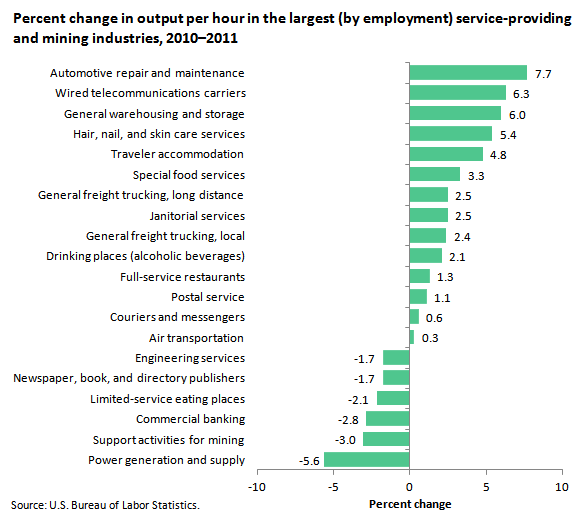An official website of the United States government
 United States Department of Labor
United States Department of Labor
In 2011, among the 20 largest (by employment) service-providing and mining industries, automotive repair and maintenance recorded the largest productivity (output per hour) increase, as output growth was accompanied by a modest decrease in hours. Productivity fell the most in power generation and supply, where hours rose while output declined.

| Industry | Percent change in output per hour |
|---|---|
Automotive repair and maintenance | 7.7 |
Wired telecommunications carriers | 6.3 |
General warehousing and storage | 6.0 |
Hair, nail, and skin care services | 5.4 |
Traveler accommodation | 4.8 |
Special food services | 3.3 |
General freight trucking, long distance | 2.5 |
Janitorial services | 2.5 |
General freight trucking, local | 2.4 |
Drinking places (alcoholic beverages) | 2.1 |
Full-service restaurants | 1.3 |
Postal service | 1.1 |
Couriers and messengers | 0.6 |
Air transportation | 0.3 |
Engineering services | -1.7 |
Newspaper, book, and directory publishers | -1.7 |
Limited-service eating places | -2.1 |
Commercial banking | -2.8 |
Support activities for mining | -3.0 |
Power generation and supply | -5.6 |
Output per hour increased in 32 of the 47 detailed service-providing industries studied. In most of these industries, productivity rose as output growth was accompanied by declines or more modest increases in hours. Several industries posted double-digit productivity gains as a result: wireless telecommunications carriers; passenger car rental; photography studios, portrait; and photofinishing. In the following industries, productivity rose as declining output was met with even greater reductions in hours: postal service; couriers and messengers; video tape and disc rental; tax preparation services; drinking places (alcoholic beverages); reupholstery and furniture repair; and coin-operated laundries and drycleaners.
Output per hour declined in four of the five detailed mining industries studied, as hours rose and output fell or grew more slowly. Only nonmetallic mineral mining and quarrying posted a productivity increase. The overall mining sector experienced a double-digit decline in productivity, as labor hours increased more than four times as much as output.
These data are from the Labor Productivity and Costs program. To learn more, see "Productivity and Costs by Industry: Selected Service-Providing and Mining Industries, 2011" (HTML) (PDF), news release USDL-13-1041.
Bureau of Labor Statistics, U.S. Department of Labor, The Economics Daily, Productivity in selected service-providing and mining industries, 2011 at https://www.bls.gov/opub/ted/2013/ted_20130531.htm (visited January 07, 2026).

